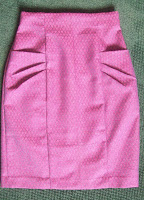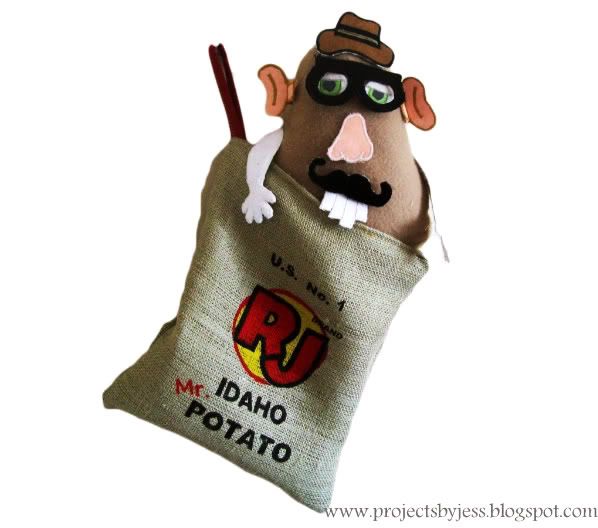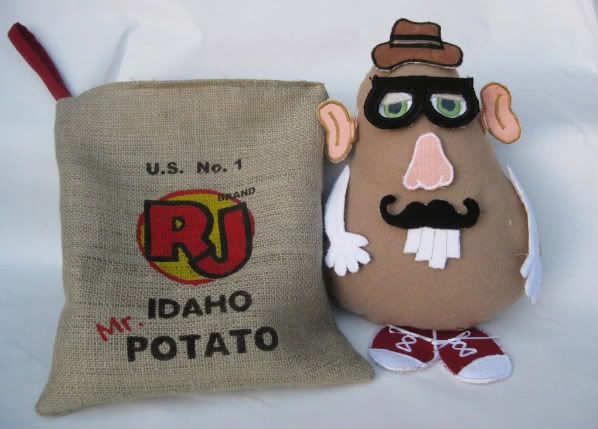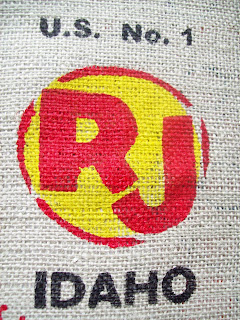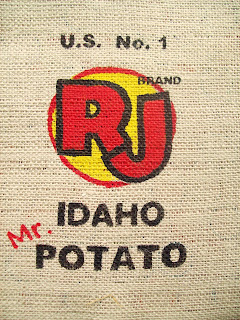
 I love Figgy Pudding by Basic Grey for Moda fabric. I've drooled over it all season long, but at $8-9 per yard, thought it would be out of reach. Recently I bought two turnover packs (6" squares cut diagonally into triangles) that were more than half off.
I love Figgy Pudding by Basic Grey for Moda fabric. I've drooled over it all season long, but at $8-9 per yard, thought it would be out of reach. Recently I bought two turnover packs (6" squares cut diagonally into triangles) that were more than half off.
I received my precious Figgy Pudding fabric triangles and for one pack decided to make a quilt. My mom's family (my grandma and her 8 daughters) are really into quilting. Designing their own patterns. Hand quilting on quilting frames. Hours of tedious work with sore thumbs. Quilt purists.
Unfortunately, I don't have quilting frames yet, or the time to make a purist quilt. I also don't own a convenient quilting machine, which would make everything easier.
So I came up with a quicker, cheaty way to make my quilt. Basically an applique quilt. Minimal geometry in the design, quilting on my standard sewing machine. For the purist quilters, this may be lame, but it was quick and fun, and I love the outcome.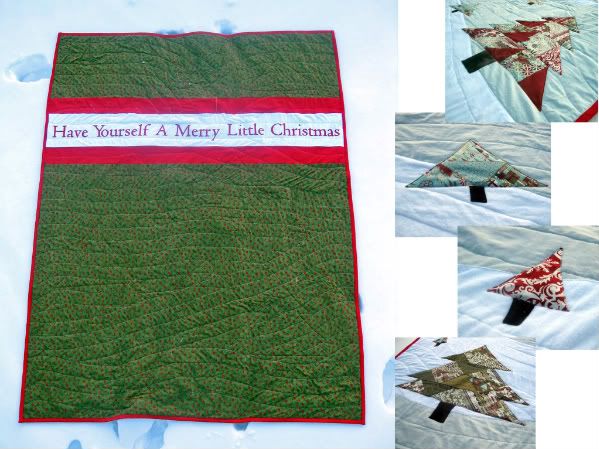

A cozy quilt for winter.
Every year at my grandparent's Christmas Eve party, we have a gift exchange--white elephant style. Everyone one is supposed to bring a $10 gift to put in the pile. You draw a number, when it is your turn you can choose to open a gift or steal a gift from someone else. We have a rule each item can only be stolen twice.
 She made the quilt from holiday flour sacks. In our area, there is a flour mill that sells baking mixes in fabric holiday print bags. They are great neighbor gifts, and apparently my Grandma had received a lot. She saved all these fabric bags and decided to make a quilt out of them. She did use an actual flour sack in the center that has the mill info on it.
She made the quilt from holiday flour sacks. In our area, there is a flour mill that sells baking mixes in fabric holiday print bags. They are great neighbor gifts, and apparently my Grandma had received a lot. She saved all these fabric bags and decided to make a quilt out of them. She did use an actual flour sack in the center that has the mill info on it.
Well each year my Grandma puts in two quilts for herself and Grandpa...way better than a $10 gift. You can imagine how these quilts are fought over during the game. Well this year I was lucky enough to have the chance to take home one of the prized quilts she'd made.
 She made the quilt from holiday flour sacks. In our area, there is a flour mill that sells baking mixes in fabric holiday print bags. They are great neighbor gifts, and apparently my Grandma had received a lot. She saved all these fabric bags and decided to make a quilt out of them. She did use an actual flour sack in the center that has the mill info on it.
She made the quilt from holiday flour sacks. In our area, there is a flour mill that sells baking mixes in fabric holiday print bags. They are great neighbor gifts, and apparently my Grandma had received a lot. She saved all these fabric bags and decided to make a quilt out of them. She did use an actual flour sack in the center that has the mill info on it.
It is hand quilted, with a solid ever-green backing. I took a DVD to the party, but took off with a handmade quilt!
There is this great blog called U-Create. It's just a lot of posts and links to great ideas. I love it.
A fabric Mr. Potato was posted, with a tutorial from MAKE IT AND LOVE IT. So you can do what I did, and use her great idea to make a potato of your own. I just want to give full credit for the fabric Mr. Potato idea to Ashley from Make It and Love It. I love these crafty blogs, they have such great ideas, and are so willing to share with others!
A fabric Mr. Potato was posted, with a tutorial from MAKE IT AND LOVE IT. So you can do what I did, and use her great idea to make a potato of your own. I just want to give full credit for the fabric Mr. Potato idea to Ashley from Make It and Love It. I love these crafty blogs, they have such great ideas, and are so willing to share with others!
I did quite a bit different potato from the Make It and Love It tutorial. The biggest changes I wanted for my own fabric Mr. Potato:
-NO POCKET ON THE BACK. It was such a cute idea, but I knew I'd want too many body parts, and they wouldn't fit in a pocket. In Ashley's tutorial she mentioned how next time she'd make a pleated pocket to hold the parts better. So as I was brainstorming ideas of what to put the body parts and potato in, I had such a great idea:
A POTATO SACK!
So I started searching for potato sack images. I found this online art exibit from Boise State University of all the Idaho potato sacks. It was a gold mine for potato sack ideas. I was browsing along, and found one Idaho logo "RJ Brand". I died. My son's name is Rhett James, but we call him RJ. So I knew that would be my potato sack model. I just love the way the potato sack turned out.
The previous post is a whole tutorial of how to make a potato carrying sack of your own!
So enough about the sack because I have a whole post on it.
OTHER CHANGES I MADE ON THE POTATO:
-No Felt. I am kind of anti-felt. Sometimes I wish I wasn't. It's cheap, you can leave raw edges, bright colors, makes crafting so easy...but I can't stand the way it feels. The fuzzy synthetic--it's like finger nails on a chalk board to me. So my potato is out of tan fleece, and all the parts are from scraps.




-Applique Body Parts: I decided I would prefer flat body parts. For two reasons, no stuffing required, and I thought if they were flat they'd lay better on the already rounded potato. Also, I was not using felt and chose to recycle the scraps I already had. So the back of each body part is a scrap of heavy upholstery with the velcro.




-Applique Body Parts: I decided I would prefer flat body parts. For two reasons, no stuffing required, and I thought if they were flat they'd lay better on the already rounded potato. Also, I was not using felt and chose to recycle the scraps I already had. So the back of each body part is a scrap of heavy upholstery with the velcro.
***One tip I've liked so far is to put the sticky/ scratchy half of the velcro on the potato, and the soft/ fuzzy side of your velcro on the parts. That way, in the sack, the parts don't stick together.



The ears are 3 pieces, so they can stand perpenicular to the potato's head out the sides. I only made one pair of ears, I'm hoping to add more ears. I need a girl pair with earrings.



The ears are 3 pieces, so they can stand perpenicular to the potato's head out the sides. I only made one pair of ears, I'm hoping to add more ears. I need a girl pair with earrings.
I use fusible interfacing for all my applique to help keep it stiff. The thick upholstery backing also helps a lot.
Some fun ideas I had on the body parts:
baseball mit hand: the elbow is bent.
shoes: embelished with ribbon and lace for the girl, ribbon shoe laces for boy
glasses: the shape of the glasses stink, not even symmetrical. but I was excited I had some plastic vinyl sheeting from when I recovered a vintage high chair. I sewed the plastic inbetween the layers for lenses. Good idea, not the cutest result. The glasses stick to the eyebrow velcro.
It all fits really well in the potato sack. There's room to add more body parts!



DISCLAIMER: I have ugly hands, and I did my best to keep them out of the little photo steps. So if you get a glance of my nasty winter split fingers, I'm sorry...I've been lotioning like crazy. I promise.
LETS GET MAKING A POTATO SACK!
First off, you'll need:-burlap about 1/3 yard: cut 2 pieces that measure 13" x 15"
-freezer paper
-fabric paint
-lining fabric: 1/3 yard: cut 2 pieces that measure 13"x15" and a pocket: 7"x9"
-zipper 14" long
-handle, make your own out of fabric, or use ribbon/ cording/etc: 12" long
**To start: here are basic freezer paper instructions if you are new to the great craft
As I mentioned in the earlier post, I found the image I used for my potato logo online at this website. I saved the image, then put it in Microsoft Word and cropped it, increased contrast, made it black and white, and made it the size it would be on the bag. RJ is my son's name.
1. You can buy freezer paper in the craft section already in printable sheets. I am cheap and have a huge roll that was $4.00. So I just tear off a chunk and use the paper cutter to trim it to 8 1/2" wide so it will fit through my printer. Make sure you print on the paper side, not the plastic side and print off copies of your logo. You'll need one freezer paper print for each color, so for me: 3 prints.
2. Print out the text you'll need for the rest of your sack the same way.


3. Cut out the letters using scissors/ craft knife.
4. Iron on the lettering freezer paper. Paint black. I only did one coat on the burlap, I wanted it to look old and worn, not a perfect screen print. You have to really shove the paint onto the burlap, more of stippling rather than brush strokes. The paint will go through the loose weave burlap, so put cardboard underneath.

5. With each of your three logo prints, cut out each color area. So you'll end up having a layer for each color.
So for yellow, it was just an oval:
BLACK: Iron on, paint
This next part I wasn't sure if I'd try. I've never freezer painted anything so small. I also wasn't sure if the big weave would mess it up and you couldn't tell what it said. The tiny inside of each letter was the hardest part. I had to pull out the tweezers. I'd place each tiny bit in the letter, then iron it in place, move to the next tiny bit.
 1. Sew pocket onto one of your lining piece. To make the pocket, I fold down the top about 1" and zig-zag across to make the top of the pocket. Then I flip it over and iron the sides in and bottom up. Pin it on the lining and sew down one side, across the bottom, and up the other side.
1. Sew pocket onto one of your lining piece. To make the pocket, I fold down the top about 1" and zig-zag across to make the top of the pocket. Then I flip it over and iron the sides in and bottom up. Pin it on the lining and sew down one side, across the bottom, and up the other side. 2. Serge or zigzag the lining to the burlap pieces. I serged the pocket lining to the blank burlap. Next I serged the painted burlap to the plain (no pocket) lining. Burlap just falls apart on the edges, so I serged them to the lining to prevent a mess and it falling apart.
2. Serge or zigzag the lining to the burlap pieces. I serged the pocket lining to the blank burlap. Next I serged the painted burlap to the plain (no pocket) lining. Burlap just falls apart on the edges, so I serged them to the lining to prevent a mess and it falling apart. 4. Sew two sides together. Put the burlap sides facing each other, making sure the top of the front is also the top of the pocket. Pin in place. Sew along the top with the longest seam length on your machine: 5. You should have 5/8" seam allowance on this seam. I only did 1/4" and that was stupid so don't do what I did in that department. You need a good chunk to attach your zipper to. Mine cut it close.
4. Sew two sides together. Put the burlap sides facing each other, making sure the top of the front is also the top of the pocket. Pin in place. Sew along the top with the longest seam length on your machine: 5. You should have 5/8" seam allowance on this seam. I only did 1/4" and that was stupid so don't do what I did in that department. You need a good chunk to attach your zipper to. Mine cut it close. 6. Baste zipper on. Take your zipper,
6. Baste zipper on. Take your zipper,  and lay it face down on the under (lining side) of the seam you just sewed. Unzip it. (I chose to put the zipper head right by the handle, so when it's finished you pull the zipper away from the handle to open it.) Take one side of the face-down, unzipped zipper and pin it to the seam allowance of one side. **Remember yours will have more seam allowance than my skimpy 1/4"
and lay it face down on the under (lining side) of the seam you just sewed. Unzip it. (I chose to put the zipper head right by the handle, so when it's finished you pull the zipper away from the handle to open it.) Take one side of the face-down, unzipped zipper and pin it to the seam allowance of one side. **Remember yours will have more seam allowance than my skimpy 1/4"
 7. Baste zipper to seam allowance. Sew the zipper to the edge seam allowance, making sure the teeth of the zipper are lined up right in the crack of your first seam.
7. Baste zipper to seam allowance. Sew the zipper to the edge seam allowance, making sure the teeth of the zipper are lined up right in the crack of your first seam.
 8. Zip up zipper. So you will have the zipper attached to your bag, face down, zipped up. 9. Flip sack to the burlap side. Sew down one side, across the bottom, and up the other side. I have a pressure foot for zippers, you sew to the side, about 1/4" from prior seam. The zipper has basic instructions that may help better than my explanation too. I left about 1/4 - 1/2" at the end with the zipper hanging out, then sewed up the other side.
8. Zip up zipper. So you will have the zipper attached to your bag, face down, zipped up. 9. Flip sack to the burlap side. Sew down one side, across the bottom, and up the other side. I have a pressure foot for zippers, you sew to the side, about 1/4" from prior seam. The zipper has basic instructions that may help better than my explanation too. I left about 1/4 - 1/2" at the end with the zipper hanging out, then sewed up the other side.
10. Trim extra zipper hanging off the one end.
 11. Unpick the first basted seam. If everything worked, you should reveal the zipper beneath.
11. Unpick the first basted seam. If everything worked, you should reveal the zipper beneath.You can unpick with a seam ripper, but I always use a straight edged razor. It's sharper and one quick slide down the seam, rather than pulling slowly down with the seam ripper.
 12. Go back up and sew across the top right next to the handle.
12. Go back up and sew across the top right next to the handle.Now that the zipper grippy thing is out of the way, you can sew across the top between the handle and zipper. Go over it a couple times for strength.
 13. Pin the handle in and leave the bag unzipped a few inches. This will help when you have to turn the bag right side out later.
13. Pin the handle in and leave the bag unzipped a few inches. This will help when you have to turn the bag right side out later. 14. Fold the sides over, so right sides (burlap) is touching. Line up the corners so it all is straight and pin the layers together. **You kind of have to squish the zipper down here.
14. Fold the sides over, so right sides (burlap) is touching. Line up the corners so it all is straight and pin the layers together. **You kind of have to squish the zipper down here.
Now you just have to sew up the sides!
 15. Starting on the right corner (no
15. Starting on the right corner (no  handle) sew down that seam, across the bottom of the bag, and back up finishing at the handle. I used 1/4" seam allowance and 2 stitch length. To get over the handle thickness, I had to lift my pressure foot a little bit. I also went back over that part to strength it.
handle) sew down that seam, across the bottom of the bag, and back up finishing at the handle. I used 1/4" seam allowance and 2 stitch length. To get over the handle thickness, I had to lift my pressure foot a little bit. I also went back over that part to strength it.
16. Trim off the bottom corners a little so when you flip it, the corners can make a crisp corner.
YOU ARE FINISHED!









